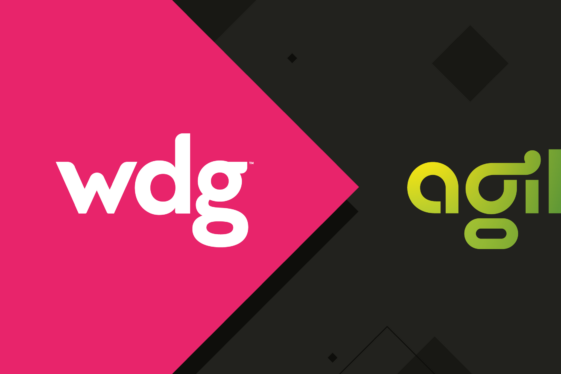WDG Hosts Refresh DC Talk About “The UI of AI”

Last week, WDG opened our new Clarendon office to a packed audience for Refresh DC. We were thrilled to have Maxim Leyzerovich, Senior Experience Lead at Capital One, discussing “The UI of AI.” With years of UX design experience, Leyzerovich is known for his deep insights about the intersection of design and technology.
Refresh DC believes in knowledge sharing and presenting a realistic, unfiltered perspective.  Founded in 2006, the massively
Founded in 2006, the massively
popular organization is 100% volunteer-run. Matt Camp, organizer of Refresh DC, explains that it is built on the idea that “we’re not experts in everything, but we’re all experts in something.” Why did Refresh DC choose to partner with Leyzerovich? “He’s got immense standing in the DC UX and front end development community,” notes Camp. “We’ve got nothing but a high regard for him, and couldn’t wait to get him in to speak.”
Examining the Roots of Artificial Intelligence
 As the audience filtered into our spacious foyer, Leyzerovich began by explaining that we unknowingly engage with technologies built on artificial intelligence (AI) everyday. These technologies curate content using complex data gathering practices. What sparked Leyzerovich’s interest in the topic? “Reading about design-centric companies who are taking a big, confident investment in AI and machine learning started me wondering, ‘What does AI have to do with design?’ ” he notes. “I began thinking that there must be a reason they are investigating these possibilities, so I wanted to explore it as well.” He believes we have finally gained enough critical mass to glean valuable insights from this data. This also means that “the more AI happens, the more invisible it is and the more we have to trust it.”
As the audience filtered into our spacious foyer, Leyzerovich began by explaining that we unknowingly engage with technologies built on artificial intelligence (AI) everyday. These technologies curate content using complex data gathering practices. What sparked Leyzerovich’s interest in the topic? “Reading about design-centric companies who are taking a big, confident investment in AI and machine learning started me wondering, ‘What does AI have to do with design?’ ” he notes. “I began thinking that there must be a reason they are investigating these possibilities, so I wanted to explore it as well.” He believes we have finally gained enough critical mass to glean valuable insights from this data. This also means that “the more AI happens, the more invisible it is and the more we have to trust it.”
Leyzerovich argues that we must mold AI into an ethical and valuable resource. Otherwise, the results could be disastrous. “I want people to engage on a deeper level with different components that go into AI and machine learning within the context of design,” he notes. Over the last twenty years, understanding how computers learn has shaped how we interact with the larger world. Some of the first forays into AI were taken by companies like Amazon and Apple who leveraged big data to improve the user experience. Today, we have “intelligent tooling” like Photoshop’s Deep Learning content-aware fill and Google’s AutoDraw. We even now have voice search capabilities built on AI. “AI can do what movies predicted twenty years ago, but now it’s our reality,” says Leyzerovich. While the possibilities are thrilling, he notes the potential for AI “is also moderately terrifying.”
How Do AI, Ethics, and Design Intersect?
“You are a data point in everything you do,” explains Leyzerovich. “This means we need an awakened passion for the idea of ethics in design, regardless of AI.” For every point of input, machine learning is actively determining and leveraging your behaviors. Today, individual mouse movements can register as a veritable fingerprint for advertisers and website administrators. Facebook even crafts models of user behavior based on your interests, allowing advertisers to retarget users based on those data points. With the widespread use of data mining from technology, the question becomes where can those technologies take us and what are the potential dangers?
Leyzerovich explains that companies like Netflix are using AI to shape how we consume media on a daily basis. Face detection,  motion detection, and how interesting an image is can influence how Netflix targets specific users. Netflix will offer different show preview frames based on your viewing habits. If you show interest in strong female leads, the Stranger Things cover might feature the main character Eleven rather the group of boys. AI is constantly learning about us. The question is, what do we still need to learn about AI?
motion detection, and how interesting an image is can influence how Netflix targets specific users. Netflix will offer different show preview frames based on your viewing habits. If you show interest in strong female leads, the Stranger Things cover might feature the main character Eleven rather the group of boys. AI is constantly learning about us. The question is, what do we still need to learn about AI?
The Future of AI is Up to Us
Speculative futures for AI development are boundless. Leyzerovich predicts companies like Google, Amazon, and Netflix will lead the future of AI. For example, Google Handwriting Input software doesn’t just predict text based on word input, but based on the actual patterns of movement when writing. Retail technologies can track customer behavior, eye movement, heat patterns, and much more to target specific buying habits through individual customer profiles. China even has a surveillance system entirely powered by AI that can locate and identify individuals in just a few minutes. “The smarter the machines get,” Leyzerovich warns, “the more out of hand they can get, and the more they can penetrate our daily lives.”
What does this mean for the future of AI? “AI will be headed to the forefront of the discussion in the next five years,” argues Leyzerovich. “It will be the topic of conversation. There will not be a discussion about design or AI without ethics. There certainly won’t be a conversation about the convergence of AI and design without ethics being at the front and center.” For example, Apple’s iPhone X now uses face ID as an input mode to test run non hand-based UI. It even now includes WebRTC, which can request access to your camera and microphone to allow direct communication inside web pages.
These tools push the boundaries of data collection practices and ethics. With the advent of these new technologies, UI must be at the forefront of the discussion to ensure new ethical protocols are put–and remain–in place. “We need human-centered AI to uphold ethical boundaries. We need to be designing for augmentation, not automation,” Leyzerovich urges.
Want to Learn More About the UI of AI?
 This is just the beginning of the conversation between AI and UI for Leyzerovich. He plans to explore this topic in a year-long initiative of speaking and writing engagements. He explains that his goal is to “explore each topic with the level of depth that someone can feel comfortable getting a broad foundation of all these concepts to bring additional knowledge to it. There’s so many moving parts, and I want to add enough knowledge to allow others to contribute to this.”
This is just the beginning of the conversation between AI and UI for Leyzerovich. He plans to explore this topic in a year-long initiative of speaking and writing engagements. He explains that his goal is to “explore each topic with the level of depth that someone can feel comfortable getting a broad foundation of all these concepts to bring additional knowledge to it. There’s so many moving parts, and I want to add enough knowledge to allow others to contribute to this.”
Want to keep up with Leyzerovich’s developments on how UI and AI intersect? Follow him on Twitter @round. You can also check out Refresh DC’s next talk by following them on Twitter at @refreshdc.
Want to get involved in a meetup or panel talk at WDG? Contact us to attend or be a featured speaker, and stay tuned to our Twitter for information on upcoming events soon.

